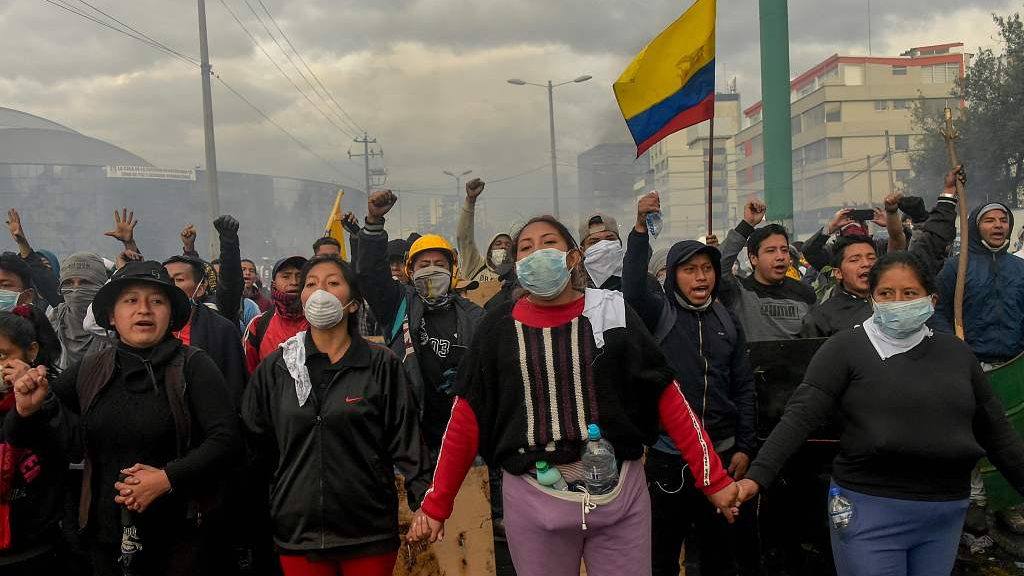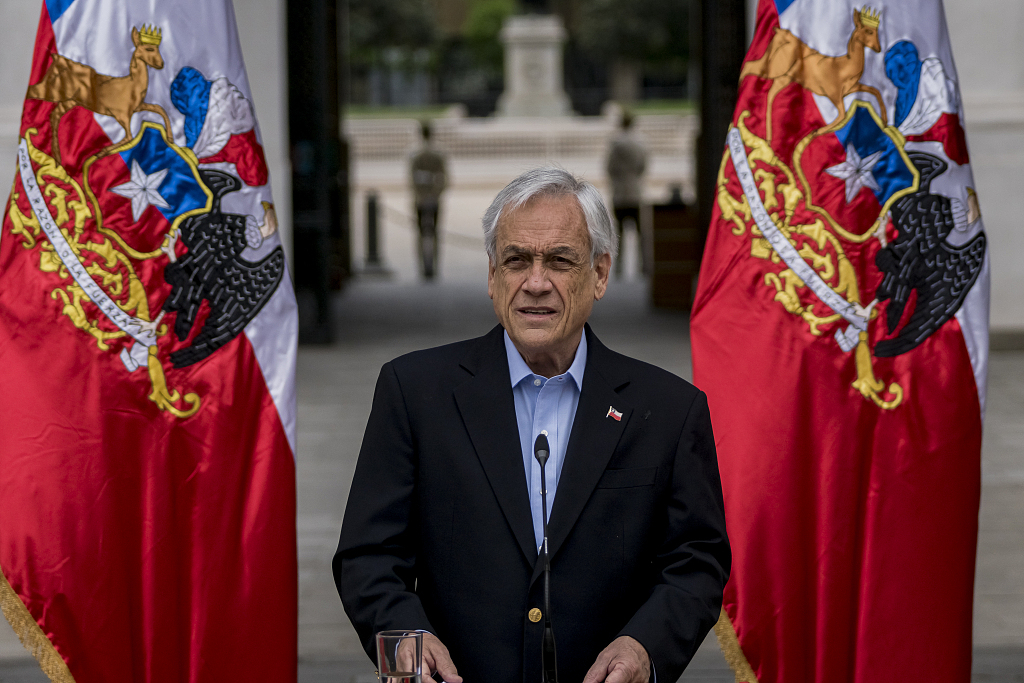
Demonstrators protest outside the Casa de la Cultura (House of Culture) in Quito, Ecuador, October 13, 2019. /VCG Photo
Demonstrators protest outside the Casa de la Cultura (House of Culture) in Quito, Ecuador, October 13, 2019. /VCG Photo
Editor's note: Pan Deng is a member of the Academic Committee at the Charhar Institute and the executive director of the Latin America and Caribbean Region Law Center of China University of Political Science and Law. The article reflects the author's opinions, and not necessarily the views of CGTN.
Latin America has been embroiled in political turmoil this October.
In Peru, the president dissolved the congress, which triggered street protests. In Haiti, demonstrators have called for the president to step down and in Bolivia, thousands of Bolivians have taken to the streets due to dissatisfaction with the presidential election results.
However, the intensity and the breadth of the unrest and violence in Chile and Ecuador have been the most concerning of all.
What triggers the unrest?
This month, Ecuador ended government fuel subsidies, which caused the diesel price to jump from 1.05 U.S. dollars to 2.27 U.S. dollars per liter in the following two weeks. As a result, taxi drivers went on strikes and paralyzed the capital's transportation system. The entire country also witnessed nationwide unrest where protesters even occupied the parliament building.
Later, Indians joined the protests and became the main force of the protests. President Lenin Moreno had to temporarily move the government from the capital to the coastal city of Guayaquil, and announced that the country entered its 60-day state of emergency.
The situation in Chile is even severer.
The subway fare in the capital Santiago was raised from 800 pesos to 830 pesos. Some high school students went to protest at the subway station. Due to the influence of social media, many citizens joined the protesters, which eventually led to large-scale violence. The government had to impose curfews and deploy the military to quell the protests.
What are the root causes?
Latin America's economic growth has always been highly dependent on agriculture and resources. It is the lack of a complete industrial chain, supply chain and value chain that has led to the rigid industrial structure, insufficient momentum for economic growth and slow transformation and upgrading of industrial structure. This economic model means that the Latin American economy is susceptible to the influence of the international environment.
In recent years, global economic growth has been slow, and the demand for resources in the international market has fallen sharply. Deeply bound by the "resource curse," the rich resources have become their disadvantage, and the pressure of economic growth has increased sharply.
According to data from the Development Bank of Latin America, the economic growth rate in this region has remained at around one percent to two percent in recent years. The Economic Commission for Latin America and the Caribbean of United Nations early predicted that the region's economic growth this year would be around 1.7 percent, but it had been lowered to 0.5 percent in August. Recently there have been further downward adjustments.

Chile's President Sebastian Pinera announces an end to the state of emergency during the protests against Pinera's government in Santiago, Chile, October 26, 2019. /VCG Photo
Chile's President Sebastian Pinera announces an end to the state of emergency during the protests against Pinera's government in Santiago, Chile, October 26, 2019. /VCG Photo
Starting from the 2015 presidential elections in Argentina, most people voted for the "neo-liberal" candidates in their countries' elections. Many of the candidates are successful businessmen. Many voters believe that if the companies of these candidates survived the financial crisis, they must be able to take the country out of the worsening economic situation.
However, because of industrial production delay and stagnant resource exports, the new leaders have to face the historical problems of insufficient public expenditure, shortage of educational resources and unreasonable social security system and tax system. There are not many cards that can be played.
The people's livelihood is the priority
Ecuador and Chile have chosen two seemingly different approaches to cope with their economic quagmires.
Lenin Moreno, the president of Ecuador, chose "to borrow." In February this year, he signed an agreement with the International Monetary Fund (IMF), which contains about 4.21 billion U.S. dollars in loans, and his government has to adopt a series of reform measures such as reducing public expenditures, creating jobs, promoting private sector-led economic growth, and increasing transparency. The "cancellation of fuel subsidies" that triggered the turmoil was part of the IMF package that aims to reduce public expenditure.
Chile chose to sputter the economy through new stimulus measures and by increasing consumption. Apart from rising subway fares, in past several months, there have been significant increases in the costs of electricity, rent and food. In addition, in the previous reforms, many of the country's public services were provided by private companies; as they also increased prices, this eventually ignited the anger of the working population.
The same result is that economic appeals have finally evolved into social turmoil and political struggles. The governments of both Chile and Ecuador chose to have a dialogue with protesters which is gradually calming the situation down.
But it's important to note that Chile's political situation and its economic development have been relatively stable for many decades. It's surprising to see the social unrest ahead of the APEC summit and COP21 to be held in Chile. Despite the tradition of confrontation between the right and left in Latin American countries, the continent has rarely witnessed protests and street politics of such a massive scale.
Either Moreno's way of raising taxes, reducing employment costs and public expenditures or Pinera's measures of sputtering the production factors through regulating the nature of markets and the mechanisms of free competition is an acceptable option to correctly answer their economic conundrums. However, neither of them could offer reform that benefits all simultaneously and equally.
If decision-makers could not balance the appeals and needs of different social classes, instead of neglecting ordinary people's well-being and only allowing a fraction of the people in society to benefit for the long term, no matter how reasonable the original intention of improving the economy is, this will lead to the division of the society and cause turmoil.
(If you want to contribute and have specific expertise, please contact us at opinions@cgtn.com.)